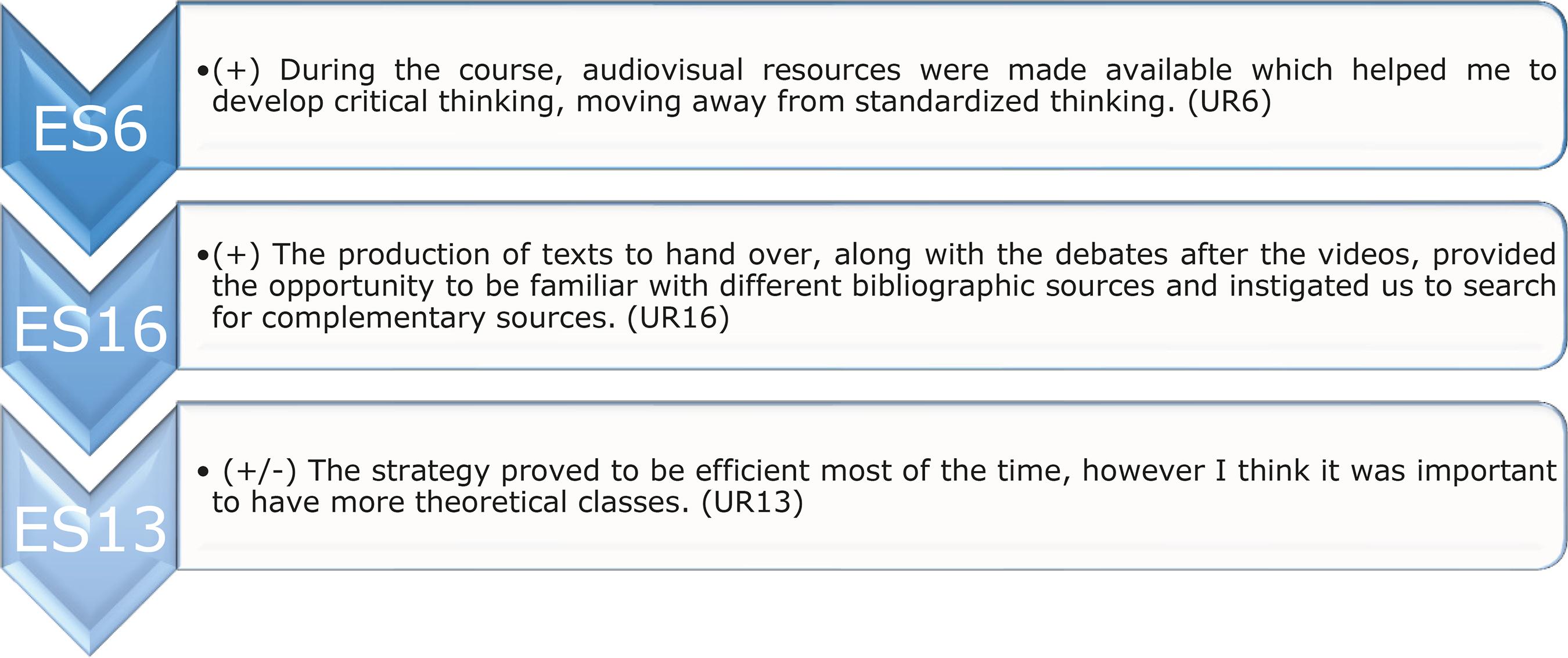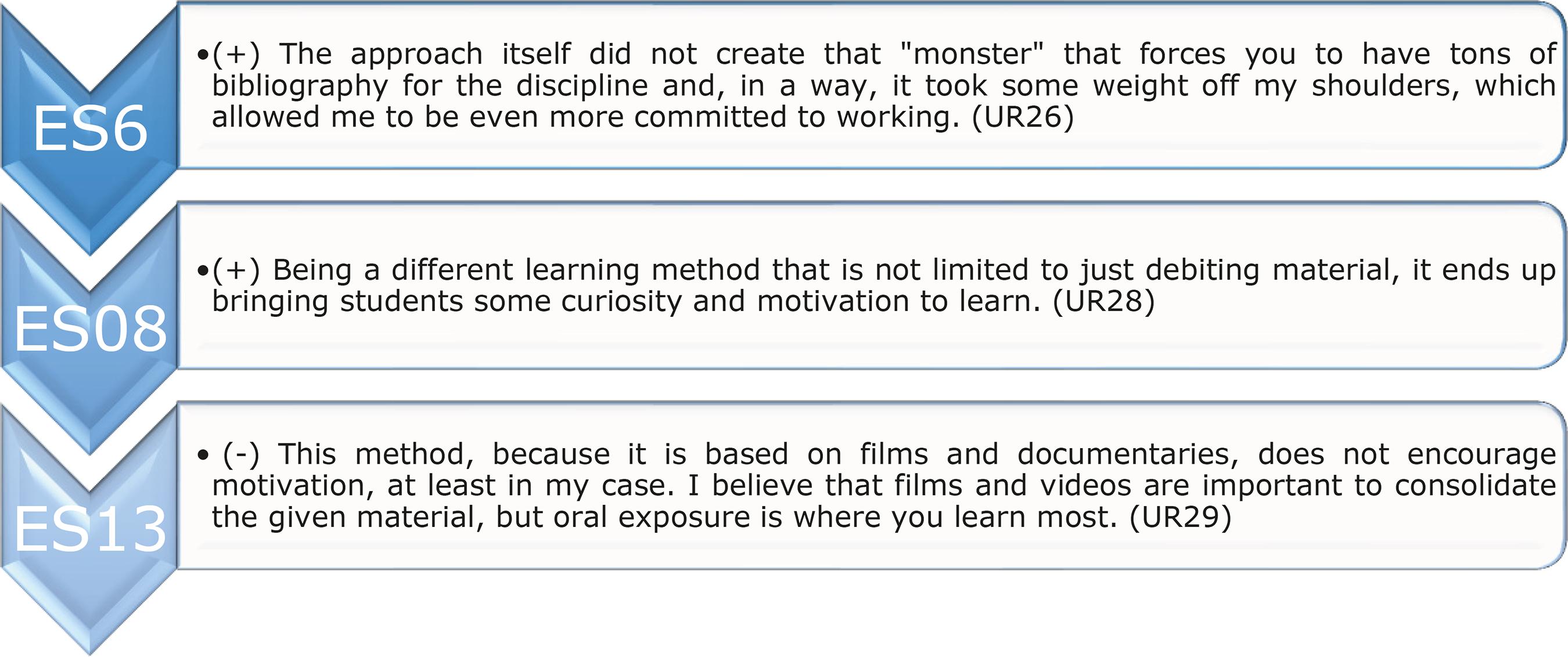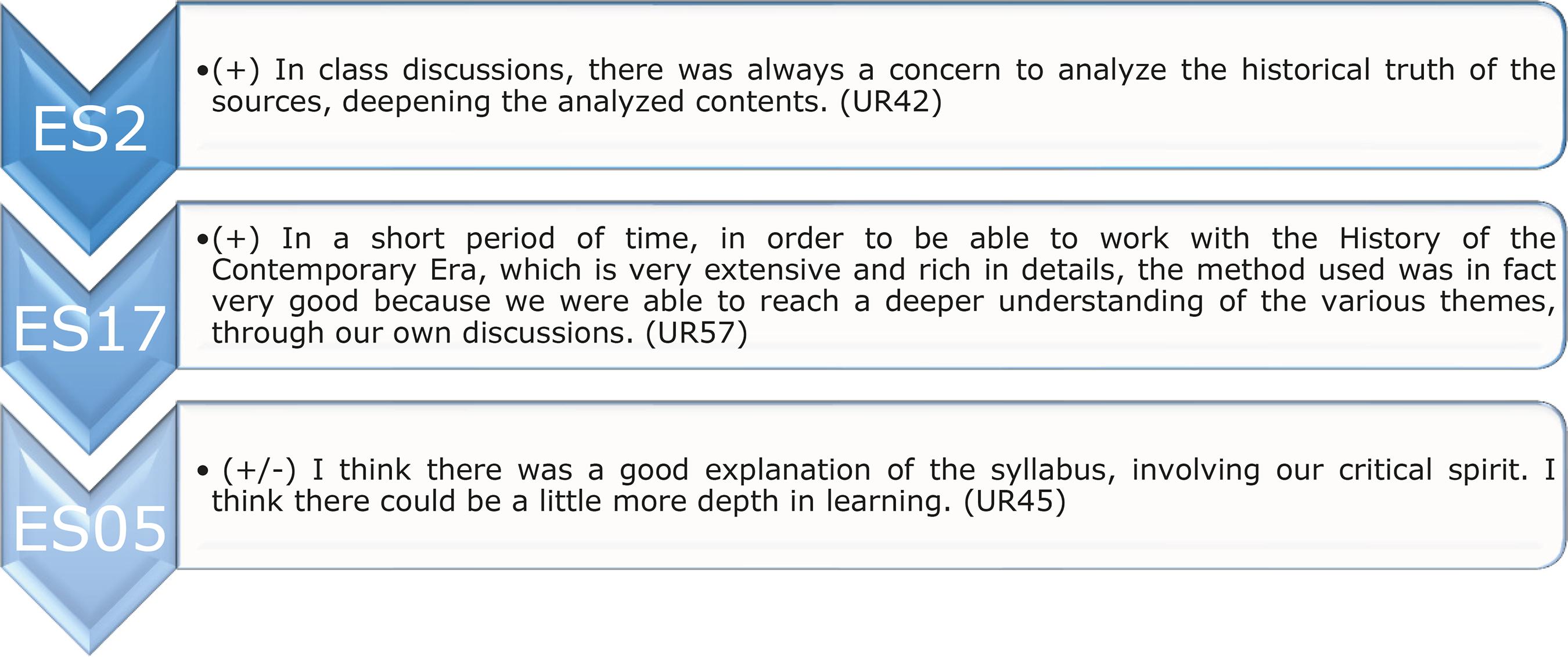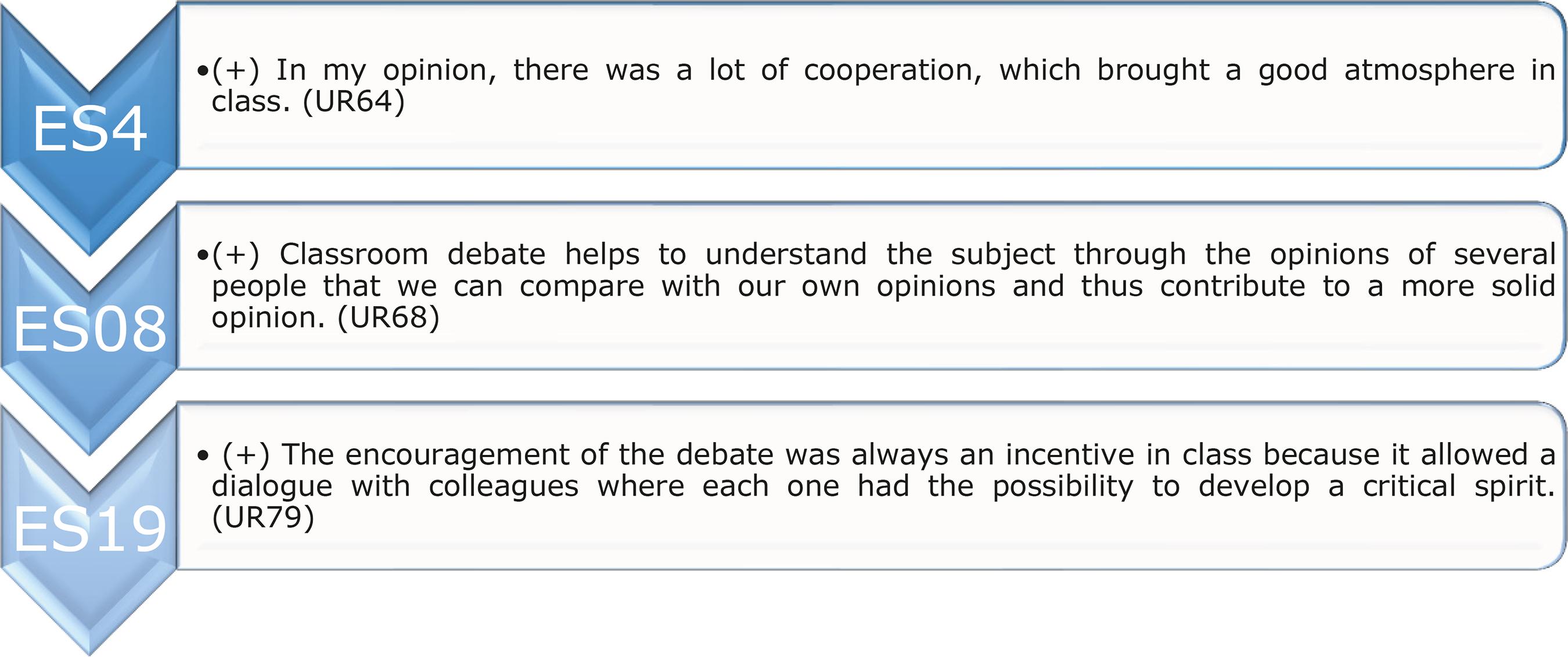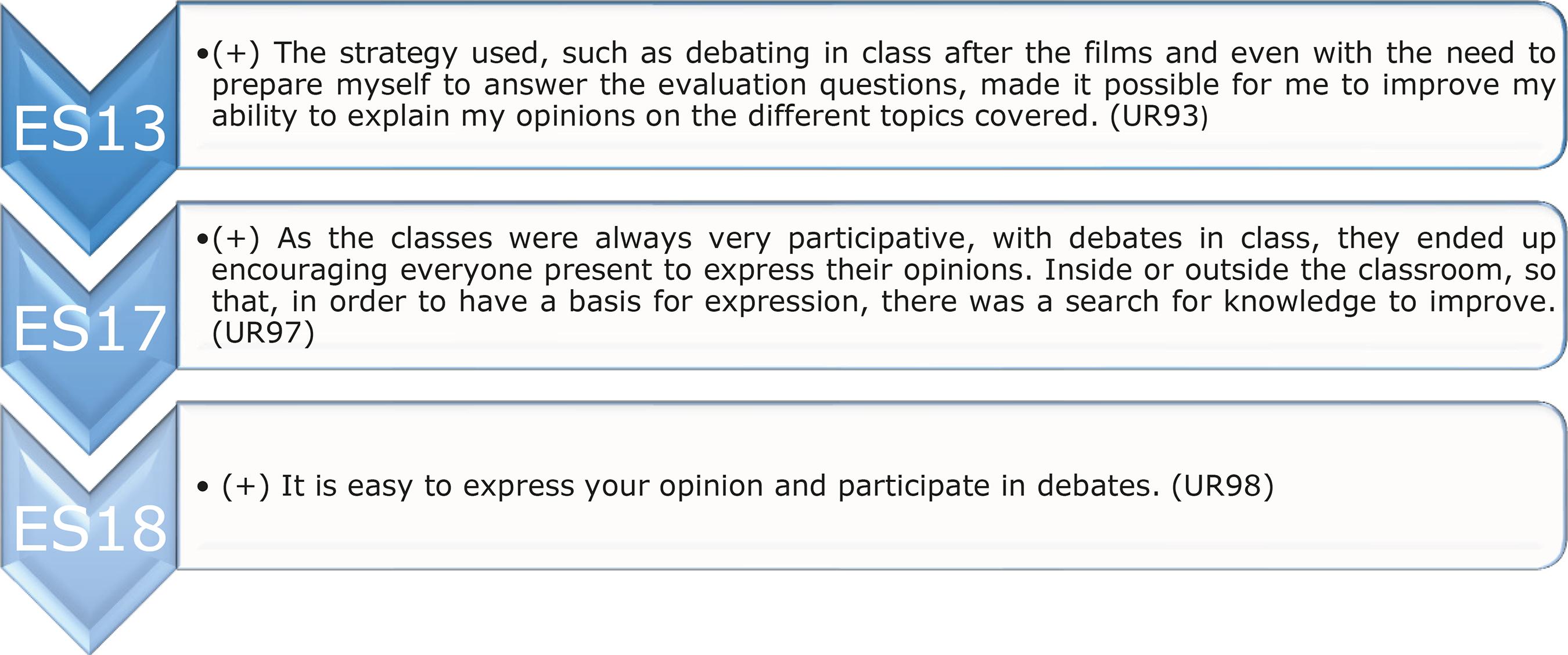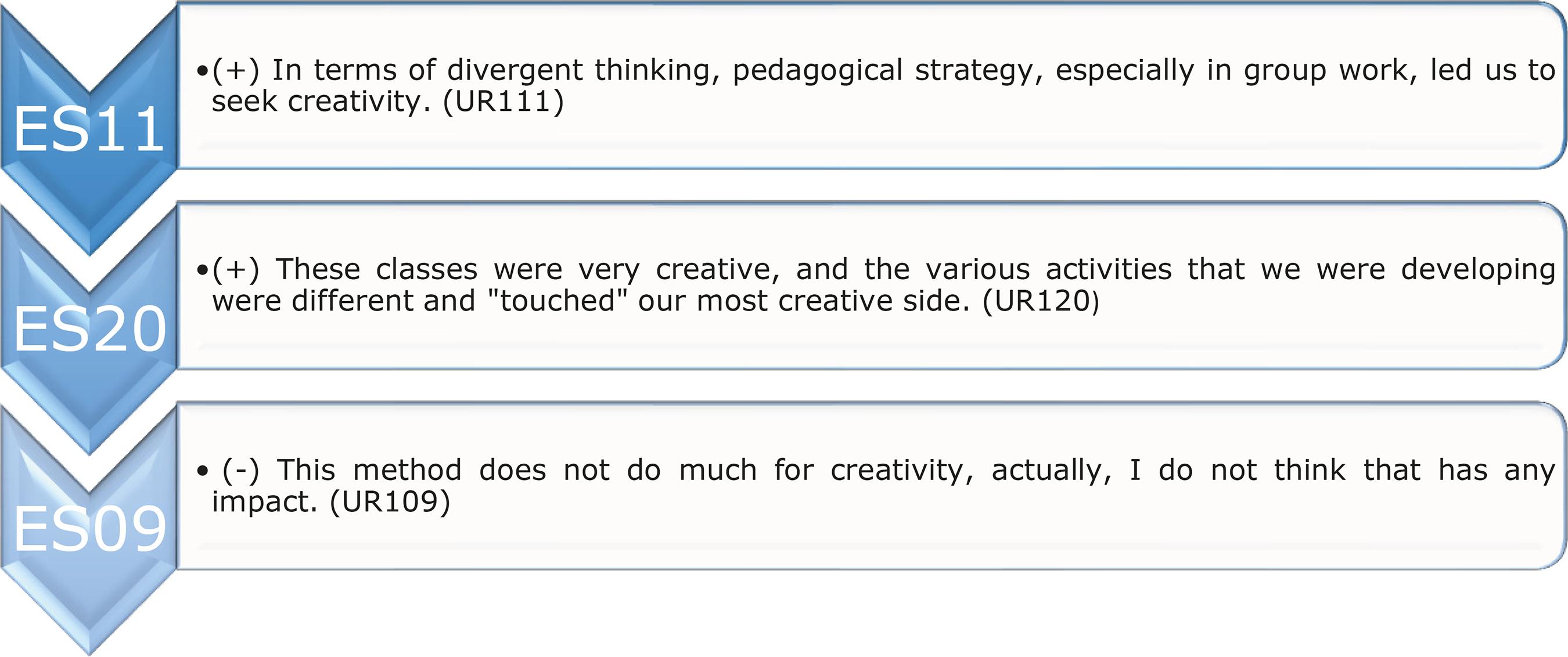Servicios Personalizados
Revista
Articulo
Compartir
Educar em Revista
versión impresa ISSN 0104-4060versión On-line ISSN 1984-0411
Educ. Rev. vol.36 Curitiba 2020 Epub 26-Nov-2020
https://doi.org/10.1590/0104-4060.76122
DOSSIER - Digital culture and education
Didactics of History in Higher Education, enriched with audiovisual technologies and its impact on the promotion of self-concept of competence1
*Universidade de Coimbra. Coimbra, Portugal. E-mail: sara.trindade@uc.pt
**Universidade Aberta. Lisboa, Portugal. Lisboa, Portugal. E-mail: jmoreira@uab.pt
Throughout this century and as a result, above all, of the changes that have taken place in society, which is increasingly immersed in a culture and digital network reality, it has become increasingly necessary to rethink the teaching and learning processes. Educational institutions, namely in Higher Education, face the challenge not only of creating learning scenarios that promote the acquisition of knowledge but also of scenarios for the development of skills. In this sense, the use of cinema in Higher Education can assert itself as a very adequate strategy to revitalize the educational experience, and it is precisely the creation of pedagogical scenarios enriched with the presence of cinema and its language that we intend to analyze, describing its impact on the self-concept of competence of twenty undergraduate students, based on the qualitative analysis of their perceptions and narratives. The results show that the design of the environment, anchored in this model and in the use of audiovisual technologies, can have very positive effects on the self-concept of competence of undergraduate students, in terms of the different dimensions considered: Cognitive, Social, and Creativity. The implications of the results found are discussed, both from practical intervention and in terms of future investigations.
Keywords: Cinema; Audiovisual technologies; Higher Education; Self-concept of competence
Ao longo deste século, e resultado, sobretudo, das mudanças que têm ocorrido na sociedade, que cada vez mais está imersa numa cultura e realidade digital em rede, tem-se tornado cada vez mais necessário repensar os processos de ensino e aprendizagem. As instituições educativas, nomeadamente do Ensino Superior, enfrentam, hoje, o desafio não só de criar cenários de aprendizagem que promovam a aquisição de conhecimentos, mas também de cenários para o desenvolvimento de competências. Neste sentido a utilização do cinema no Ensino Superior pode afirmar-se como uma estratégia muito adequada para revitalizar a experiência educacional, e é precisamente, a criação de cenários pedagógicos enriquecidos com a presença do cinema e da sua linguagem que pretendemos analisar, descrevendo o seu impacto no autoconceito de competência de vinte estudantes de graduação, a partir da análise qualitativa das suas percepções e narrativas. Os resultados mostram que o design do ambiente, ancorado neste modelo e na utilização de tecnologias audiovisuais, pode ter efeitos muito positivos no autoconceito de competência dos estudantes de graduação, a nível das diferentes dimensões consideradas: Cognitiva, Social e Criatividade. São discutidas as implicações dos resultados encontrados, tanto do ponto de vista de intervenção prática, quer em termos de investigações futuras.
Palavras-chave: Cinema; Tecnologias audiovisuais; Ensino Superior; Autoconceito de competência
Introduction
Education today faces great changes, mainly because of the societal advances that have been occurring, and that, naturally, brought new needs to the labor markets. It is therefore essential that educational institutions contribute to promoting the so-called "skills for the 21st century" (WEF, 2015), which are related not only to the acquisition and development of knowledge but also to the way students approach complex problems and constant changes in the environment in which they operate.
These students, the main actors in this process, are now profoundly accustomed to circulating between real and virtual spaces, to communicate with each other quickly, to access immeasurable sources of information with the touch of a finger. They are avid consumers of content, but sometimes they find it difficult to distinguish the essential from the expendable, right from wrong, even the way they can circulate through the "information highway."
It is in this context that teachers continue to play a fundamental role in the educational process. Although today they are not exclusive holders of knowledge, they still have the primary task of knowing how to guide their students through information and helping them to build quality learning.
Conceiving education, and the teaching and learning process as mechanisms of joint and continuous growth, based on experiences that can be enhanced by the use of digital and active, collective and network learning, requires "that participation is observed as a way to build a sense of belonging and identity in the network of authors and mediators of experiences, scenarios and learning contexts" (DIAS, 2012, p. 4). Therefore, an ecological perspective of education is needed, where teachers and students work together to develop new knowledge.
For this to happen, educational institutions must provide their students with the opportunity to participate in a pluralistic society, going beyond traditional forms of literacy (MILLS, 2010; AMASHA, 2012; MOREIRA, 2017).
Despite being quite used to the consumption of different contents, such as images, films, or games, concerning cinema, young people tend, even when it presents itself as an educational resource, an eminently passive posture. However, integrating cinema in education can help open space not only to foster certain curricular learning but also to help educate the eye to see the film as an object and not just as a source (FERREIRA, 2018), since the impact on how students can build their knowledge from it is undeniable (CIPOLINI, 2008).
In fact, from a very early age, cinema was used with an educational aspect, inside and outside the educational space. However, the use of film as a didactic resource has a more recent history, as the ability of films to gain relevance for different areas of knowledge is increasingly noticeable, with more and more didactic proposals for their exploration (COELHO, 2016).
Thus, more and more scientific and academic works are exploring cinema in an educational context, presenting different studies that show how to take advantage of the wealth of information that can be taken from the analysis of the simplest set of moving images (BERGALA, 2008; MACHADO, 2008; NAPOLITANO, 2010; MOREIRA; FERREIRA, 2016; MORAN, 2016; MOREIRA, 2017; FERREIRA, 2018; DIAS-TRINDADE, 2018).
Because the exploitation of cinematographic content can be so rich, as Reigada (2013) says, "it is not enough to see a film. We have to analyze it with a critical eye […] to […] value cinema as a storyteller, as a transmitter of values and as a carrier of art and knowledge" (REIGADA, 2013, p. 66). Therefore, it takes time to explore cinema in the classroom, but it has to be understood as a useful time. To understand the film in all its dimensions, it is necessary to prepare how it will be integrated into the context of learning, and leave space for further reflection on what has just been viewed. To overcome this issue, different strategies can be found, namely through short films or the choice of short, more significant stretches of long works (CAMPOS, 2006; ALVES; ALVES, 2016; TRINDADE; RIBEIRO, 2016).
Considering, therefore, the potentialities of cinema enunciated, we developed our practice based on a pedagogical model centered on the “deconstruction” of moving images, intending to evaluate its impact in dimensions such as the ability to discuss and solve problems, to apply knowledge in practice; investment and motivation in learning; the ability to express opinions and initiate actions; the ability to cooperate, and the ability to be creative.
This is a model whose lines of strength and theoretical principles are based on learning: constructivist and collaborative that stimulates reflection and critical discourse, individual and social responsibility and the creative spirit; based on interaction, assuming interaction as a principle underlying the pedagogical process, determining both for motivation, encouragement and mutual trust; promoter of Multiliteracy (MOREIRA, 2017).
In summary, our research aims to envision possible scenarios and alternative learning designs enriched with audiovisual technologies, studying the effect of this model on the development of the self-concept of competence in dimensions such as problem-solving, communication, collaboration, and creativity.
Cinema and audiovisual language in the teaching of (contemporary) history
The richness of the use of cinema in an educational context is that it does not need to serve only to understand a given curricular subject, because if students are familiar with the language of cinema, they can read, study, interpret the film, analyze its production, its main characteristics and take the film to didactic situations related to other knowledge (SÁNCHEZ, 2003). The actual analysis and active participation in the deconstruction of cinematographic images and their potential meanings can generate countless and important learnings, namely contributing to the development of the self-concept of competence.
In the case of history, “films, whether or not images of reality, documents or fiction, authentic intrigue or pure invention, are history” (FERRO, 1988, p. 29). Although susceptible to criticism, as stated by Ferro (1988) or Burke (2004), the spectator mustn't forget that, in most cases, they are not facing any historical source before the filmed history, there is a need to remember that it is an “act of interpretation” (BURKE, 2004, p. 200). In fact, as Lagny (2009, p. 108) says: "cinema also encounters historians' questions and doubts that they often experience about their interpretations and, increasingly, about the vestiges left by the past."
This possibility of understanding films as exercises in the interpretation of history, which seek to establish relations between facts and coherent explanations, happened since the 1960s when the first cinema journals specially dedicated to historians appeared, and universities began to contemplate courses on audiovisual studies.
However, it is up to the historian to know how to treat secondary sources (and the film can be analyzed precisely in this way),
whose criticism always involves a decomposition of the message and its framing in a concrete time and context that often provide the keys for decoding the objectives and information that the source conveys or intends to convey, that is, the underlying intentionality (TRINDADE; RIBEIRO, 2016, p. 28).
The historian is not, nor does have to be, a cinema specialist, however, their analysis may involve trying to understand the facts presented, using the cinema and its contents as instruments (LAGNY, 2009). This is its relevance since it allows us to answer, interrogate, put it into context, and even create contemporary history (SOBCHACK, 1996; LAGNY, 2009). Still, in 1898, the Polish photographer Bolesav Matuszewski believed, in a text written for Le Figaro, that through cinema “it would be possible to see the facts, as they happened” and that the “fabrication of history” would be witnessed. (quoted by GEDULD, 1971, p. 9).
In this sense, using cinema and audiovisual language in the Teaching of Contemporary History seems to be a valid strategy. Not only as a strategy of historical construction but also as a way of analyzing history itself through the lens of different directors, viewing cinema, precisely, as a secondary source. Articulating the possibilities of reconstituting recent historical scenarios, together with the promotion of critical thinking, the analysis of context, content, what is present in the film, and even what is not, educational scenarios can be developed where the learning focus is on skills and the call for mobility advocated in the current framework, guided by the Bologna Process, are promoted.
In an educational context, and particularly concerning the study of history, the possibility of attracting students to different historical contexts, can contribute to the construction of a perception of the past, grounded and contextualized, in addition to building representations of reality, it can bring out different ways of seeing, feeling or thinking (LAGNY, 2009, p. 110). Rosenstone (1997, p. 53) states that “the audiovisual world unites elements that written history separates”, and that can better express an entire social, emotional, and even plurisignificant context of history, which the written text does not allow.
Caparrós Lera (2008) quotes David Griffith who, in 1915, wrote that “the moment will come when children in schools will learn everything through films; they will no longer be forced to read history books”. It will certainly be too radical. However, education for film language is important, especially as a very valuable resource for the development of learning in general and, in particular, concerning the construction of contemporary historical knowledge. The film can be not only an instrumental source, useful not only as a way to see the past reconstituted but even to understand the director's thinking or the mentalities of the time, leaving the students to understand and learn to work to use film analysis as a strategy, too, for creativity development.
Ferro says that, when cinema appeared, elites described it as “a machine for stupidity and dissolution, a pastime for illiterate and miserable creatures, worn out by their work” (FERRO, 1988, p. 26). As mentioned above, the association of cinema with study or the construction of historical knowledge also took its time to be accepted, especially among the academic community.
However, there is an increasingly widespread perception that the past can be perfectly revived or observed through an aesthetic-creative perspective (SANTAELLA, 1994), and that cinema can be an instrument of reflection to be read and interpreted correctly (LAGNY, 2009).
Caparrós Lera (2008, p. 139) explains, in this context, that, a) there are films that present historical reconstructions, “fiction films - or fiction films - that require the attention of the historian, researcher or pedagogue”; b) historical fictions, not so rigorous, but still of interesting analysis; and c) films of historical reconstruction, “fundamental works as sources of historical investigation and as a media medium. But they need a rigorous analysis as to what they serve as a new rewriting of historical science” (CAPARRÓS LERA, 2008, p. 141).
Methods
Design-Based Research (DBR) was the investigative approach chosen, as it constitutes a rigorous and reflective type of research to test and improve innovative learning environments (WANG; HANNAFIN, 2005), where teachers are admittedly co-researchers, contributing to the development of design theory, to lead to the implementation of innovations.
This methodology seeks to research educational problems in real contexts of pedagogical performance, to solve significant and practical problems, reconciling theory and practice through a collaborative link between researchers and professionals who seek to understand, document, interpret and improve educational practice.
Content analysis (BARDIN, 1977; VALA, 1986) was the investigative technique chosen, coding the semi-free and disorderly statements of the survey, to raise the emergence of data related to the study. Firstly, a fluctuating reading of all responses was made as a way of aligning common themes and detecting particularities. Then the units were separated and numbered sequentially. For this purpose, we present the information from the responses, also in a schematic, intending to exemplify the relevance of some of their opinions.
Taking into account the scope and objective of the study, as well as the documentary analysis of some relevant norms in the context under study, we were inspired by the Self-Concept of Competence Scale (SCCS, Escala de Autoconceito de Competência in Portuguese) developed by Faria, Santos, and Bessa (1996), to build our instrument. Thus, as we can see in Table 1, the three dimensions that constitute the SSCC were those that we defined for our instrument.
TABLE 1 SELF-CONCEPT OF COMPETENCE SCALE
| Dimension | Sub-dimension |
|---|---|
| Cognitive | Problem-Solving - evaluating the perception of competence in the domain of cognitive learning, problem-solving, and application of knowledge to practice |
| Sophistication for Learning - which evaluates the perception of competence in the field of investment and motivation in learning | |
| Prudence in Learning - which evaluates the perception of competence in the domain of precision and depth in learning | |
| Social | Social Cooperation - evaluating the perception of competence in the field of cooperation with others |
| Social Assertiveness - which assesses the perception of competence in the social domain, especially the ability to express opinions, make new knowledge, and initiate actions | |
| Creativity | Divergent Thinking - evaluating the perception of competencies linked to creativity |
SOURCE: The authors.
Our sample consisted of a group of 20 participants, from the History and Art History courses at the University of Coimbra. Their ages ranged between 18 and 52 years old, an average of 21 years old, with a predominance of female members (75%) (Table 2).
Results
Before presenting the results, it is important to note that the data analysis followed a logic of operation based on the alternation of two phases. In the first phase, vertical analysis of each of the responses was carried out, and in the second, we carried out a horizontal or comparative analysis, using the method of “constant comparative analysis” (MILES; HUBERMAN, 1994) to identify common and distinctive aspects of the representations and perceptions of these students. For this purpose, we present the information from the responses in a schematic, to exemplify the relevance of some of their opinions. It should also be noted that the registration units, due to their evaluative nature, were signaled with the expressions Positive Trend (+), Negative Trend (-), and Hesitation / Indefinition (+/-).
Thus, in the sub-dimension Problem Solving, referring to the domain of cognitive learning, problem-solving, and the application of knowledge to practice, the classification of the recording units was divided by the frequencies of Positive Tendency (+) and Negative Tendency (-). The first, Positive Trend, was the one that received almost all of the references, nineteen records, which suggests that students consider that the strategy developed fostered the learning of the contents covered and allowed the resolution of the problems that were arising.
As we can see in the first recording unit example, the student -ES6- mentions that audiovisual resources were made available, which allowed him to develop his critical thinking. The possibility he had to reflect and to discuss allowed him to move away from the thought he calls “standardized”.
In turn, the student -ES16-, as we can see in the second registration unit (UR16), highlights that the viewing of films and the subsequent debate that took place after this viewing was important to instigate the discussion and research of different bibliographic sources.
The opinions of the students -ES17-, -ES18- and -ES19- also highlight, in different ways, the relevance of the strategy for solving the problems raised.
ES17- “[…]Several sources were presented for the resolution of the questions asked, such as bibliography, documentaries, films, debates were held in class and works that made us put into practice the resolution of different questions.” (UR17)
ES18- “I believe that the pedagogical strategy is correct, generating debates, using different platforms and a very innovative method of learning history. That does not seek to present big dates, but seeks to analyze, criticize and think”. (UR18)
ES19- “The pedagogical strategy was very enriching, as it allowed a more critical reflection on problems that emerged in the contemporary era. This method allowed an approximation to the contents taught, so I managed to develop a more scientific reflection of my problem”. (UR19)
Although everyone has the opinion that the strategy promoted the ability to solve problems, through reflection, discussion, and critical analysis, while students -ES17- and -ES19- emphasize problem-solving, student -ES18- highlights the innovative character of the strategy, combining discussions in a live environment with discussions on digital learning platforms.
Finally, it should be noted that, as we can see in the third registration unit, there is a student -ES13- who does not seem to have liked this way of learning, saying that it would be important to have more theoretical, expository classes, perhaps more masterful teaching.
In the second sub-dimension, Sophistication to learn, regarding the perception of competence in the field of investment and motivation in learning, the classification of the registration units was divided by the frequencies of Positive Trend (+) and Negative Trend (-). The first, Positive Trend, was the one that again received almost all references, eighteen records, which suggests that students consider that the developed strategy motivated their involvement and investment in academic activities; the second, with only two records, reflects, according to those records, the inability of this strategy to motivate some students.
As we can see in the first exemplary registration unit in Figure 2, the student -ES06- mentions that the approach motivated him a lot, above all, because it relieved the “tons” of bibliography that teachers normally indicate.
Another student -ES05- also highlights the issue of increasing motivation rates:
ES05- “[…]there was motivation in learning the content and the possibility to investigate more about each topic; using debates from specialized people in the field to have another approach ... there was a different learning from the usual ... we had debates with another type of intellectuality”. (UR25)
In turn, the student -ES08-, as we can see in the second exemplary registration unit, consider that the method, being different from the usual one, brought curiosity and motivation.
Therefore, a new relationship was generated between knowledge and learning, between a more theoretical and a more practical dimension, as can be seen in the words of the student -ES01: “Compared to other disciplines the motivation was greater. The classes were never entirely theoretical, it did not make me lose the nexus of the subjects taught” (UR21).
It is also interesting to highlight the student's perception -ES17-, which highlights the high levels of motivation and: ES17- “Audiovisual resources and technologies have stimulated change in the way of studying” (UR37).
However, not all statements go in this direction, with higher motivation rates, hence some reservations that we should have in reading the results. As we can see in the third exemplary recording unit in Figure 2, the student -E13- states that this model and strategy did not motivate him, believing that films are only important to consolidate the contents, since, in his opinion, a pedagogy based on oral is the most valid.
Finally, in the third sub-dimension, Prudence in Learning, referring to the perceptions of competence in the domain of precision and depth in learning, the classification of the registration units again reveals a very high number of positive trend perceptions (sixteen), which indicates that the strategy allowed students to deepen, with precision, the contents taught.
As we can see in the first recording unit in Figure 3, the student -ES02- refers that the debates that occurred after viewing the films were very important, on the one hand, to analyze the historical truth of what was viewed and, on the other, to deepen the themes discussed and analyzed. The student -ES10- underlined the same idea, highlighting that: ES10- “With this method, I was able to develop my research capacity, since I had to look for alternative sources to the audiovisual resource” (UR50).
However, and as in the previous dimension, the students' position is not unanimous. As we can see in the third exemplary registration unit in Figure 3, the student -ES05- as well as the -ES15- consider that more and more depth could be given to the topics covered.
In turn, in the second dimension, referring to the social dimension, and the two sub-dimensions considered, respectively, in terms of assertiveness and social cooperation, we found unanimity in considering this model. It is very valid for the creation and construction of a solid learning community and robust, as it made it possible to strengthen social relationships and ties between all elements of the class.
As we can see in the three registration units in Figure 4, the students report that there was a lot of cooperation between all elements of the class, and the very stimulating debates, allowed a better understanding of the contents and allowed the development of a critical spirit.
In turn, in terms of Social Assertiveness, we see in Figure 5 that students highlight the dynamics of existing debates, which helped to stimulate and improve the ability to expose ideas and opinions publicly, which ended up strengthening the social ties between the elements of the class, with exchanges of information and knowledge that contributed to good academic performance.
On the other hand, the environment generated by social participation allowed some shier students to also participate in a more actively. ES10- “I am a person who has difficulty expressing opinions or discussing topics publicly. The realization of this method allowed me to be able to express, in writing, my opinions” (UR90).
Finally, in the third dimension, referring to Creativity, we find that the majority (eighteen) of students consider that this model promotes the development of divergent thinking. This is a model that requires active participation in learning, starting by providing an in-depth analysis through the deconstruction of the audiovisual object that guarantees an increase in cognitive flexibility through the various examples that it sees deconstructed. This participation, naturally, requires reflection, maturation of knowledge, and cognitive flexibility. It is, in reality, a model that focuses on cases that are analyzed or deconstructed according to multiple perspectives or themes and that considers two learning processes: the deconstruction process and the process of thematic crossings (MOREIRA, 2017).
As we can see in the first two registration units in Figure 6, students -ES11- and -ES20- highlight that the strategy implemented had an impact on the level of creativity, especially in terms of group activities that “touched” the creative side of each one.
In the same sense, the student -ES04- underlined these ideas, saying that: “This strategy opened up space for discussions on various topics, and I think it was very positive, as we learned to have critical thoughts and to learn from different opinions” (UR104).
However, and as in previous dimensions, it should be noted that there is no unanimity in the perceptions. For example, the student -ES09- mentions that the method had no impact on his creativity, an opinion shared by the student -ES03-, who, it should be noted, are the only ones who disagree.
Conclusion
Using cinema in the classroom is neither a game nor entertainment. Films have already been introduced into daily life mainly through television and, therefore, it is almost impossible not to make it profitable in the classroom (SÁNCHEZ, 2003).
Besides, it was based on these assumptions, and taking into account the potential of cinema, that we decided to develop our pedagogical practice based on a pedagogical model centered on the “deconstruction” of moving images.
The result of our study considering these perceptions reveals that, effectively, this model and the pedagogical strategies developed can have very positive effects on the self-concept of competence from undergraduate students, in terms of the different dimensions considered: Cognitive, Social, and Creativity.
Through the analysis of the students' perceptions in these three dimensions, we could conclude that the pedagogical strategy with the use of cinema allowed creating a favorable environment and promoting a critical thinking process favorable to problem-solving. A collaborative environment, where the student assumed the duty to make sense of their educational experience, through the negotiation of meanings with the group and where information and knowledge were shared with creativity.
Regarding the Cognitive dimension, we conclude that students consider that the strategy fostered the learning of the contents covered, the resolution of problems, motivated their involvement and investment in academic activities, and allowed to deepen the taught contents with precision.
In turn, in terms of the Social dimension, we could conclude that the model facilitated the creation and construction of a solid and robust learning community, has even made it possible to strengthen social relationships and ties between all elements of the class.
Finally, at the level of Creativity, we conclude that the students from this research consider that this model promotes the development of divergent thinking.
We can affirm, based on the perceptions of these students, that this strategy, which relies on the viewing of films and anchored by a constructivist pedagogical model, has enormous potential for the development of the self-concept of competence from higher education students.
If one thinks of cinema as a work of art, as an image that has to be appreciated and seen as an object thought by an artist, then "it cannot be conceived by the student without the experience of ‘doing’" (BERGALA, 2008, p. 30). And this experience can and must go not only through the practical analysis of what the film can show but also, through the critical analysis and synthesis, competencies that are integrated into the range of key competences for the 21st century.
The active enjoyment of the film is the motto for the transformation of the viewer. "The meaning and significance of a film, even if it is proposed or configured in a significant way by an author, is concretized above all in the process of subjective and particular experimentation of the film by each viewer" (ALVES; ALVES, 2016, p. 16 ). Putting in the student's hands this enjoyment of an artistic genre composed of so many different elements, which form a narration that can instigate to so many and varied comments and reflections (SÁNCHEZ, 2003), is effectively transforming cinema into a successful start, in the sense in which the film becomes the means so that quality, motivating and fully appropriate learning for the new millennium will be able to occur.
Nóvoa refers that "the reality-fiction of cinema promotes, in fact, the readings and interpretations of the social strata that, directly or indirectly, control the means of cinematographic production" (NÓVOA, 1995, p. 35). Calling the cinema to school, guiding students in a complete, active, and participatory enjoyment when viewing any film, and betting on methodologies that encourage autonomous learning will, without a doubt, be an unavoidable "box office success".
REFERENCES
ALVES, Luís Alberto; ALVES, Pedro. Aprender com o cinema: da narrativa à didática. In: MOREIRA, José António; FEREIRA, Vitor (org.). Cinema e Educação: convergências para a formação cultural, social e artística. Santo Tirso: Whitebooks, 2016. p. 13-31. [ Links ]
AMASHA, Azlinda. A review of "the multiliteracies classroom". Language and Education, [s. l.], v. 26, n. 5, p. 473-476, 2012. [ Links ]
BARDIN, Laurence. L´analyse de contenu. Paris: PUF, 1977. [ Links ]
BERGALA, Alain. A hipótese-cinema: pequeno tratado da transmissão do cinema dentro e fora da escola. Rio de Janeiro: Booklink: CINEAD-LISE-FE/UFRJ, 2008. [ Links ]
BURKE, Peter. Testemunha ocular: história e imagem. Bauru: Edusc, 2004. [ Links ]
CAMPOS, Rui Ribeiro. Cinema, geografia e sala de aula. Estudos Geográficos, Rio Claro, v. 4, n. 1, p. 1-22, jun., 2006. [ Links ]
CAPARRÓS LERA, José María. Grandes acontecimentos históricos contemporáneos en el cine. En: CAMARERO, Gloria; HERAS, Beatriz; CRUZ, Vanessa (ed.). Una ventana indiscreta: la historia desde el cine. Madrid: Ediciones JC, 2008. p. 131-147. [ Links ]
CIPOLONI, Arlete. Não é fita, é fato: tensões entre instrumento e objeto. Estudo sobre a utilização do cinema na educação . 2008. 159 f. Dissertação (Mestrado em Educação) - Faculdade de Educação da Universidade de São Paulo, São Paulo, 2008. [ Links ]
COELHO, Constança Silva. O filme como recurso didático. In: MOREIRA, José António; FEREIRA, Vítor (org.). Cinema e Educação: convergências para a formação cultural, social e artística. Santo Tirso: WhiteBooks, 2016. p. 53-69. [ Links ]
DIAS, Paulo. Comunidades de educação e inovação na sociedade digital. Educação, Formação & Tecnologias, Monte de Caparica, v. 5, n. 2, p. 4‐10, dez. 2012. [ Links ]
DIAS-TRINDADE, Sara. Ferramentas digitais para desenvolvimento de cenários de aprendizagem onde o cinema pode ser a estrela. In: MOREIRA, José António; ALVES, Pedro; GARCIA, Francisco (org.). Fusões no cinema: educação, didática e tecnologia. Abordagens teóricas e metodológicas . Madrid: ICONO14, 2018. p. 113-125. [ Links ]
FARIA Luísa, SANTOS, Nelson L.; BESSA, Nelson. Auto-conceito de competência: adaptação de um instrumento a adolescentes portugueses. In: ALMEIDA, Leandro et al. (org.). Avaliação Psicológica: Formas e Contextos. Braga: APPORT, 1996. v. IX. p. 165-176. [ Links ]
FERREIRA, Rodrigo de Almeida. Luz, câmera e história: práticas de ensino com o cinema. Belo Horizonte: Autêntica Editora, 2018. [ Links ]
FERRO, Marc. Cinema and History. Detroit: Wayne State University Press, 1988. [ Links ]
GEDULD, Harry M. Focus on D.W. Griffith. Englewood Cliffs: Prentice Hall, 1971. [ Links ]
LAGNY, Michèle. O cinema como fonte de história. In: NÓVOA, Jorge; FRESSATO, Soleni Biscouto; FEIGELSON, Kristian (org.). Cinematógrafo: um olhar sobre a história. Salvador: UFBA; São Paulo: Editora Unesp, 2009. p. 99-131. [ Links ]
MACHADO, João Luís Almeida. Na sala de aula com a sétima arte. São Paulo: Editora Intersubjetiva, 2008. [ Links ]
MILES, Matthew; HUBERMAN, Michael. Drawing valid meaning from qualitative data: toward a shared craft. Educational Researcher, [s. l.] , n. 13, p. 20-30, 1994. [ Links ]
MILLS, Kathy A. The multiliteracies classroom. Bristol: Multilingual Matters, 2010. [ Links ]
MORAN, José. Desafios da televisão e do vídeo à escola. 2016. Disponível em: http://www.eca.usp.br/prof/moran/site/textos/tecnologias_eduacacao/desafio.pdf. Acesso em: 07 ago. 2018. [ Links ]
MOREIRA, José António. A pedagogical model to deconstruct moving pictures in virtual learning environments and its impact on the self-concept of postgraduate students. Journal of e-Learning and Knowledge Society, Italy, v. 13, n. 1, p. 77-90, 2017. [ Links ]
MOREIRA, José António; FERREIRA, Vítor (org.). Cinema e Educação: convergências para a formação cultural, social e artística. Santo Tirso: WhiteBooks, 2016. [ Links ]
NAPOLITANO, Marcos. Como usar o cinema na sala de aula. São Paulo: Contexto, 2010. [ Links ]
NÓVOA, Jorge. Apologia da relação Cinema-História. O olho da História, Salvador, n. 1, 1995. [ Links ]
REIGADA, Tiago dos Santos. Ensinar com a sétima arte: o espaço do cinema na didática da História. 2013. 381 f. Dissertação (Doutorado em História) - Faculdade de Letras da Universidade do Porto, Porto, 2013. [ Links ]
ROSENSTONE, Robert. El pasado en imágenes: el desafio del cine a nuestra idea de la historia. Barcelona: Ariel, 1997. [ Links ]
SÁNCHEZ, Enrique Martinez-Salanova. El valor del cine para aprender y enseñar. Comunicar: Revista Científica de Comunicación y Educación, España, n. 20, p. 45-52, 2003. [ Links ]
SANTAELLA, Lucia. La historia del arte y el arte de la historia. Diálogos de la Comunicacíon, n. 40, p. 58-63, 1994. [ Links ]
SOBCHACK, Vivian. Introduction: history happens. In: SOBCHACK, Vivian (ed.). The persistence of history: cinema, television and the modern event. New York: Routledge, 1996. p. 1-15. [ Links ]
TRINDADE, Sara Dias; RIBEIRO, Ana Isabel. O espaço do cinema na didática da História. Revista de Linguagem do Cinema e do Audiovisual, Rio de Janeiro, n. 2, p. 27-34, 2016. [ Links ]
VALA, Jorge A análise de conteúdo. In: SILVA, Augusto Santos; PINTO, José Madureira (ed.). Metodologia das Ciências Sociais. Porto: Edições Afrontamento, 1986. p. 101-128. [ Links ]
WANG, Feng; HANNAFIN, Michael J. Design-based research and technology-enhanced learning environments. Educational Technology Research and Development, [s. l.], v. 53, n. 4, p. 5-23, 2005. [ Links ]
WEF (WORLD ECONOMIC FORUM). New vision for Education: Unlocking the Potential of Technology. Cologny/Geneva: World Economic Forum, 2015. [ Links ]
Received: July 28, 2020; Accepted: September 13, 2020











 texto en
texto en 


